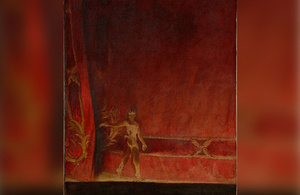Rare portrait of the dancer Nijinsky may leave UK permanently
A portrait of the greatest male ballet dancer of the early twentieth century, Vaslav Nijinsky, is at risk of export

Image of the painting
Arts Minister Rebecca Pow has placed a temporary export bar on an incredibly rare painting of the Russian dancer Nijinksy in a bid to keep it in the country.
‘Nijinksy before the Curtain’ by Glyn Philpot is at risk of being lost abroad unless a buyer can be found to match the asking price of £450,000 plus VAT.
Philpot (1884 - 1937) was an English painter who specialised in male portraiture, including, sometimes controversially, the male nude. Among his subjects were the poet Siegfried Sassoon and the operatic tenor Vladimir Rosing.
The painting in question depicts the Russian ballet dancer Vaslav Nijinsky taking a curtain call after a performance of ‘L’Après-midi d’un faune’. The work shows Nijinksy in costume as the faun on stage at the Royal Opera House in Covent Garden, London, where he performed in the UK premiere of the ballet in 1913.
Nijinsky, the greatest male dancer of his generation and also a highly inventive choreographer, was born in Kiev in 1890 to Polish parents. He was brought up in Russia and trained at the prestigious Imperial School of Dancing in St. Petersburg. In 1909, Nijinsky joined the Ballets Russes where he became the principal male dancer and rose to international stardom.
By 1912, Nijinsky had begun choreographing original ballets including ‘L’Après-midi d’un faune’, ‘Jeux’ and ‘Till Eulenspiegel’. The ballet evoked in this painting caused controversy because of the graphic depiction of sexual desire in the final scene and the overtly erotic subtext of the piece.
The Ballets Russes had a profound effect on British art and culture, as prior to their visit in 1913, there was no national school of ballet or any permanent companies in Britain, unlike many other European countries. This work is a unique representation of Vaslav Nijinksy on stage in London and represents a pivotal moment in British cultural history.
Arts Minister Rebecca Pow said:
Nijinksy is one of the most famous dancers of the twentieth century and his impact on our cultural history is huge. Thousands of children across the UK attend dance lessons every day and this is due in no small part to Nijinsky and the Ballets Russes introducing ballet to the British cultural scene. I hope that a buyer can be found to keep this important work in the country.
The Minister’s decision follows the advice of the Reviewing Committee on the Export of Works of Art and Objects of Cultural Interest (RCEWA). Representations of Nijinsky in British collections are very rare and the committee felt that this work was of national importance to the study of dance.
The RCEWA made its recommendation on the grounds of the painting’s outstanding significance for the study of the history of dance.
Committee Member Pippa Shirley said:
This painting is a highly significant work of art in its own right, but perhaps more than that, it captures a seminal but fleeting moment in the history of dance. It shows Nijinsky, arguably the greatest dancer the world has seen, in a rarely-depicted curtain call for the first ballet which he choreographed himself and at precisely the moment when he was taking the British stage by storm with the Ballets Russes.
It is an unusual and powerful image, which tells us much about the impact of a cultural phenomenon on the artistic life of the country at the time, influencing the public, artists and patrons alike.
The decision on the export licence applications for the painting will be deferred until 18 October 2019. This may be extended until 18 January 2020 if a serious intention to raise funds to purchase it is made at the recommended price of £450,000 plus VAT.
ENDS
Notes to editors
- Organisations or individuals interested in purchasing the painting should contact the RCEWA on 0845 300 6200.
- Details of the painting are as follows: A painting of the Russian ballet dancer Vaslav Nijinsky taking a curtain call by Glyn Philpot (1884-1937). Oil on canvas. 755 x 625 mm. 1913. Good condition.
- Provenance: Sir Philip Sassoon by March 1914; Bequeathed in 1939 to his cousin Hannah Gubbay (d. 1968); [….]; Acquired by a UK private collector in the 1980s and by descent to 2017.
- The Reviewing Committee on the Export of Works of Art and Objects of Cultural Interest is an independent body, serviced by The Arts Council, which advises the Secretary of State for Digital, Culture, Media and Sport on whether a cultural object, intended for export, is of national importance under specified criteria.
- The Arts Council champions, develops and invests in artistic and cultural experiences that enrich people’s lives. It supports a range of activities across the arts, museums and libraries – from theatre to digital art, reading to dance, music to literature, and crafts to collections.